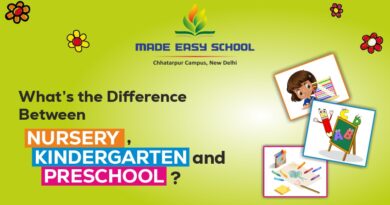Why Play Matters in Early Childhood Education
We have often heard the saying ‘kheloge kudoge to hoge kharab’, but with the changing times, the view has changed. When we think of learning, we often picture books, classrooms, and quiet study time, but for young children, learning looks a little different; it looks like playing. That’s right: play is at the heart of early childhood education, and it’s one of the most powerful tools we have to help children grow, learn, and thrive.
Today, in this post, we’ll explore that in a world that often rushes to test scores, milestones, and measurable achievements, it’s easy to overlook something beautifully simple: play, because in the realm of early childhood education, play isn’t just downtime; it’s the foundation for lifelong learning, confidence, and development. Along with that, we will cover the benefits of play in early childhood education, how kids truly learn through play, and why educators and parents should embrace it as a cornerstone of early learning development. Let’s start with what early childhood education is…
What Is Early Childhood Education?
Early childhood education generally refers to the learning and development that takes place from birth up to around age eight. As per the experts, it’s a crucial time when a child’s brain is growing faster than at any other point in life. It’s not just about getting kids ready for school. It’s about helping them become curious, confident learners with strong social-emotional skills, solid language foundations, and a sense of wonder about the world.
So, Why Is Play So Important?
Let’s understand it with an example: just think about the last time you watched a child deeply engaged in building with blocks, pretending to be a firefighter, acting like an astronaut, or mixing colours at a paint table. That wasn’t “just playing”. It was learning in action. Play-based learning isn’t new; it’s how children have always made sense of the world. When children play, they’re not only having fun; they’re developing essential skills they’ll carry for life. Let’s look at some of the most important benefits of play in early childhood education:

- It Builds Brain Power
Play helps children develop critical thinking and problem-solving skills. Simple activities like sorting shapes, building towers, or completing a puzzle actually lay the groundwork for math, science, and logic later on, and when kids engage in pretend play — like playing house or running a make-believe shop they’re using memory, language, and imagination all at once. That’s real cognitive work happening in real time.
- It Supports Social and Emotional Growth
One of the biggest life lessons kids learn through play? How to get along with others. Whether they’re negotiating roles in a game, figuring out how to share toys, or comforting a friend, children build emotional intelligence and empathy through everyday play interactions. These social skills are just as important as academics, especially in the early years.
- It Encourages Communication
From babbling during a peek-a-boo game to explaining the rules of their made-up world, children practice language constantly through play. It gives them space to express themselves, ask questions, and enhance their vocabulary in a way that feels natural and fun. Reading books, singing songs, word-making activities, and storytelling are also wonderful ways to weave language-rich experiences into playtime.
- It Promotes Physical Development
Play isn’t just a brain booster, it’s also key to growing strong, healthy bodies. Running, climbing, dancing, throwing, digging, all of these activities develop gross motor skills. Meanwhile, painting, stringing beads, and working with playdough help with fine motor control, which is essential for future tasks like writing and tying shoes.
- It Sparks Creativity
Open-ended play fuels imagination. Give a child a cardboard box and watch it turn into a spaceship, a grocery store, or a pirate ship. This kind of unstructured play helps children think creatively, solve problems in unique ways, and feel confident in their ideas, and let’s be honest the world needs more creative thinkers.
Types of Play That Support Early Learning
Different types of play offer different learning experiences. Here’s a quick breakdown of what you might see in a quality early childhood education setting:

- Free play: Unstructured, child-led play that encourages independence and creativity.
- Guided play: Play where adults gently scaffold learning by asking questions or introducing new materials.
- Dramatic play: Pretend play where children explore roles, feelings, and real-world scenarios.
- Sensory play: Activities that stimulate the senses (like water tables or sandbox play), helping kids explore textures, sounds, and more.
- Cooperative play: Group play where children learn to collaborate and work toward shared goals.
How Kids Learn Through Play: A Few Real-Life Examples
Let’s bring this to life. Here are a few ways kids are learning through play every single day: Playing “restaurant” helps children practice maths (for this, you can ask them to count their toys or even money), literacy (writing menus), and social skills (taking turns as customer or chef). Building with blocks teaches problem-solving, spatial awareness, and even the basics of engineering. Digging in a garden box leads to lessons in science, patience, and taking care of living things. These aren’t just games; they’re meaningful child development activities that promote early learning development in the best way possible.
Preschool Learning Tips for Parents and Educators:
Want to make the most of play at home or in the classroom? Here are some simple, effective preschool learning tips to guide you:
1. Set Up an Inviting Environment: Create spaces that encourage curiosity and hands-on exploration, a quiet corner for reading, a shelf of building toys, a table for art. Rotate materials regularly to keep things fresh and engaging.
2. Observe and Join In: Watch what your child is drawn to, and let that guide the day’s learning. Join their world ask questions, offer support, and be present without taking over.
3. Mix Play with Purpose: Add gentle learning goals into everyday play. Want to work on counting? Play a board game. Practicing letters? Set up a pretend post office. Learning doesn’t have to be separate from play they go hand in hand.
4. Celebrate Mess and Mistakes: Learning through play can be loud, messy, and sometimes chaotic and that’s okay. These moments are filled with discovery. Embrace the process, not just the outcome.
5. Keep It Balanced: Offer a mix of structured activities and time for free play. Too much structure can stifle creativity, while too little guidance can leave kids unsure. A good balance helps children thrive.
Bridging Play and Academic Readiness
Some adults worry that play doesn’t prepare children for “real” school. But here’s the truth: play is school for young children. Through play, they learn how to follow instructions, stay focused, cooperate with others, and express themselves, all skills they’ll need in a classroom and beyond. By supporting learning through play, we’re helping children build strong foundations for literacy, numeracy, emotional regulation, and social understanding. These are the tools that will carry them through their entire educational journey.
Final Thoughts: Let’s Keep Play at the Heart of Learning
It can be easy to overlook the value of play, especially in a world that often prioritizes academics and test scores. But for young children, play is learning. It’s how they discover the world, develop essential skills, and make meaningful connections. As parents, teachers, and caregivers, the best gift we can give is space and time to play. By supporting play-based learning and trusting in the power of curiosity, we help children become lifelong learners — joyful, confident, and ready for whatever comes next.
FAQs
What types of play are best for early learning?
Many games can be used for early childhood education in the ocean of games. The best types of play for early learning are the ones that spark curiosity, invite creativity, and encourage exploration. Think of activities like imaginative play, pretending to be a doctor or chef; sensory play; playing with sand and water; and construction play, like building with blocks or Legos. Cooperative games where kids play together are also great for teaching social skills. The key is to offer a mix of open-ended play and gentle guidance so kids can learn while doing what they love most: playing.
Why is play more effective than rote learning for pre-schoolers?
Learning through play is more effective than memorisation at this age because it appeals to children’s natural curiosity, practical thinking, and imaginative nature. When young children play, they do not simply memorise information but actively think, experiment, and try to understand the “why” behind everything. While a child may learn to repeat the alphabet by rote, play helps him recognise letters in real-life contexts, such as recognising the letter ‘M’ on a restaurant board or writing his name in the sand. This kind of experiential and meaningful learning not only remains in memory for a long time but also deepens children’s ability to think, understand, and express.
How can teachers use play in the classroom for better engagement?
Teachers can weave play into the classroom by designing learning centres that encourage exploration — like a pretend grocery store, a building zone with blocks, or a quiet nook for reading. They can use songs, movement, storytelling, and art to teach key concepts. Most importantly, teachers can step into the play with their students — asking thoughtful questions, sparking new ideas, and supporting social interactions. When kids are engaged and having fun, they’re naturally more open to learning.
How do parents support early childhood development at home?
Parents play a huge role in early development just by being present and responsive. You don’t need fancy toys or apps — simple things like reading together, playing pretend, going on nature walks, or cooking side-by-side can do wonders. Creating a safe, loving space where your child feels encouraged to explore and express themselves is the foundation of healthy development. And when you follow their interests, ask questions, and join in their play, you’re showing them that their ideas matter — which builds confidence and curiosity.
Why is active play important in early childhood?
Active play — like running, jumping, climbing, and dancing — isn’t just about burning off energy. It’s crucial for developing coordination, balance, and strength. It also helps kids learn about space, movement, and their own abilities. Plus, active play gives children a healthy way to release emotions and reduce stress. Whether it’s a game of tag, an obstacle course, or just a dance party in the living room, these moments keep their bodies and minds growing strong.
Why is role play important in early childhood?
Role play is like magic for growing kids. When kids pretend to be soldiers, doctors, firefighters, teachers, or even animals, they’re not just having fun — they’re exploring real-world roles and practicing empathy. Role play builds social skills, language, problem-solving abilities, and emotional understanding. It helps children try out different perspectives, make sense of their experiences, and develop confidence. Plus, it’s one of the easiest ways to sneak in learning without it ever feeling like a lesson.




